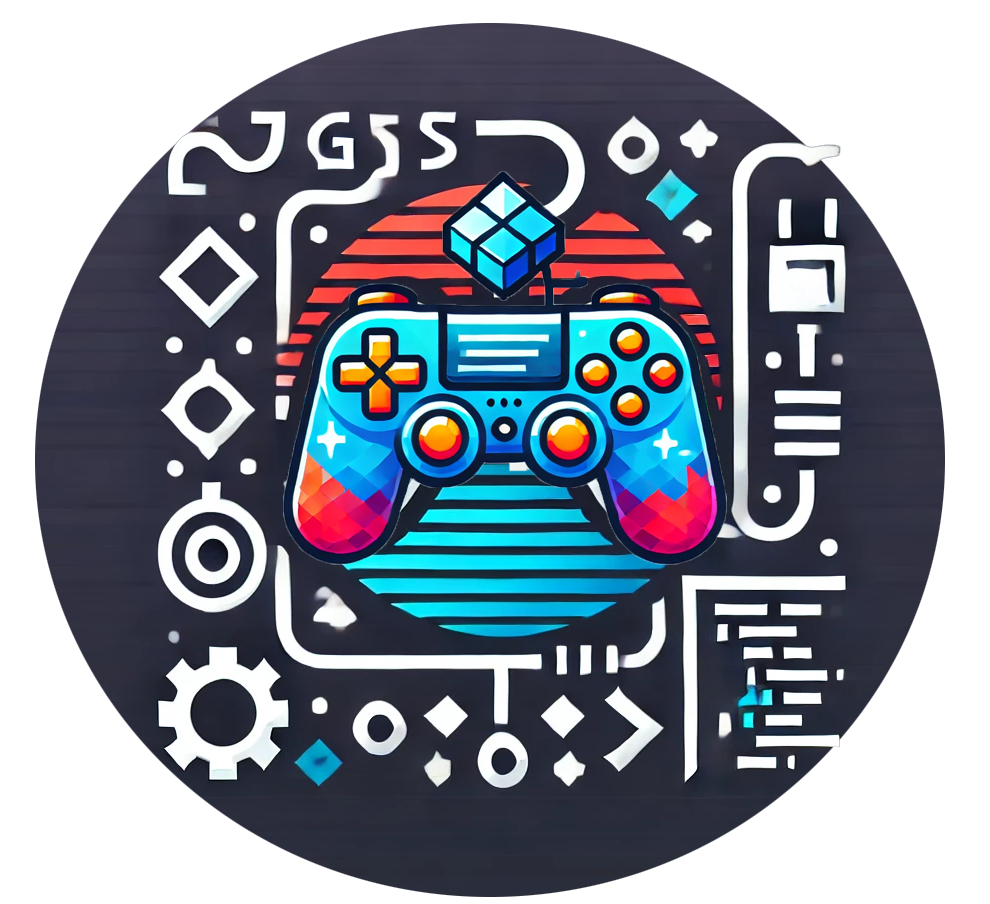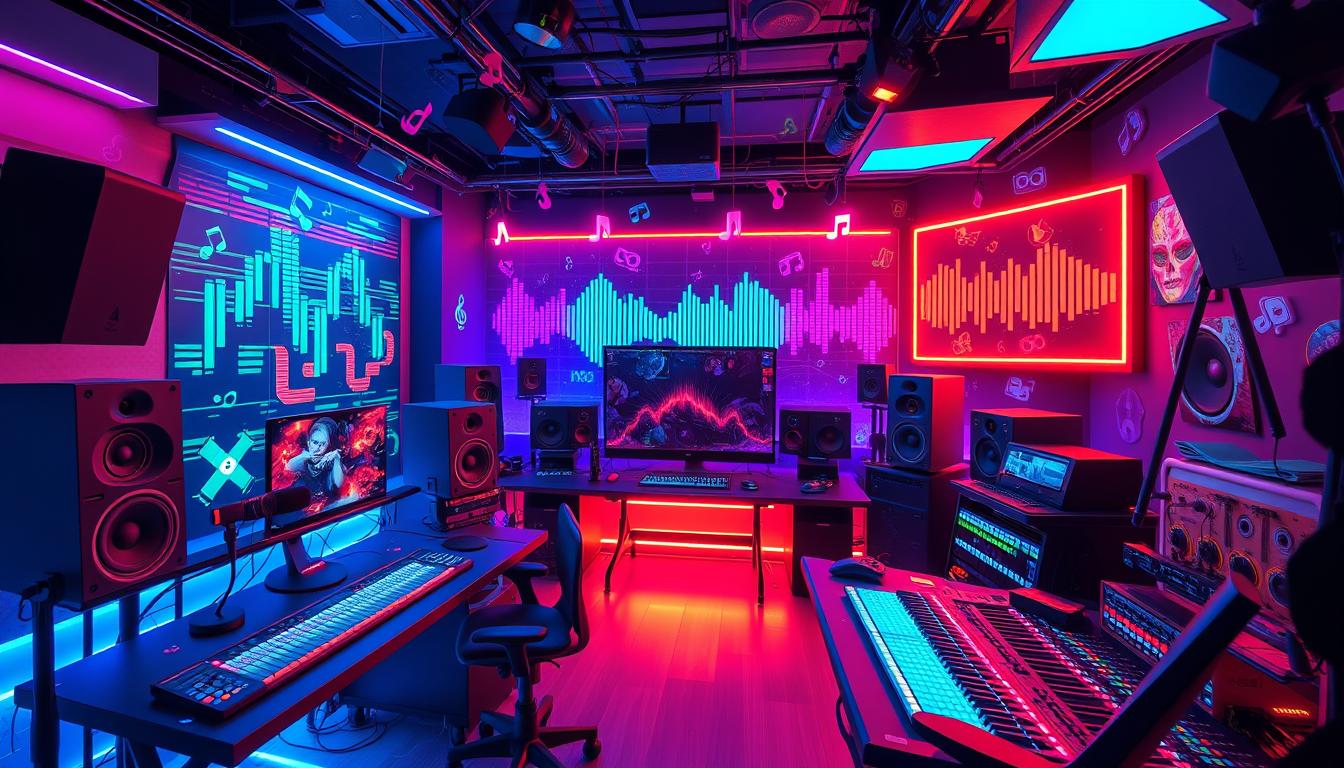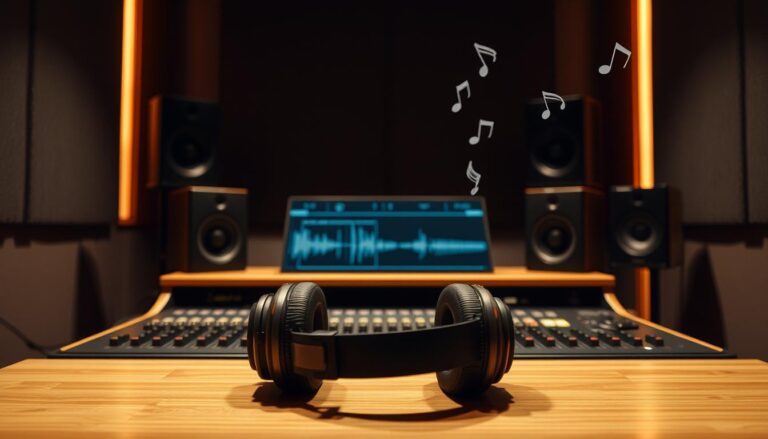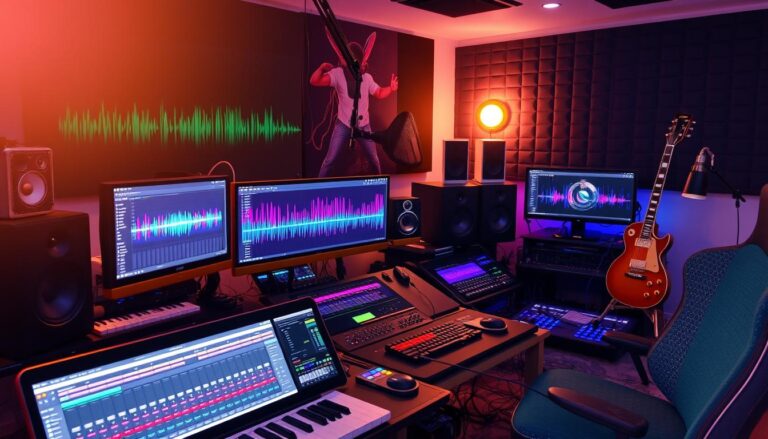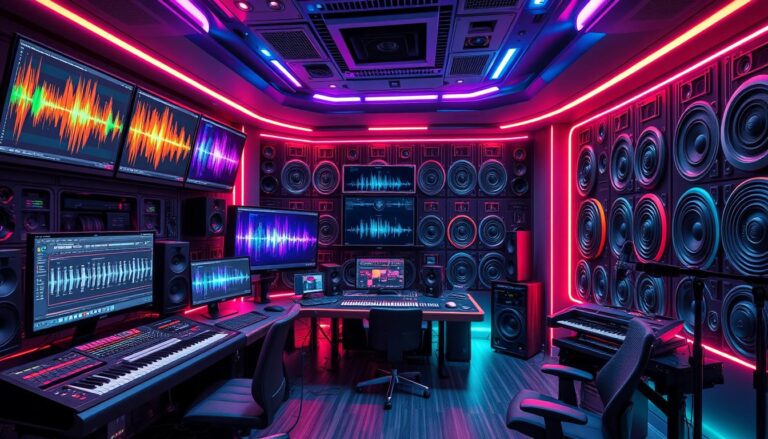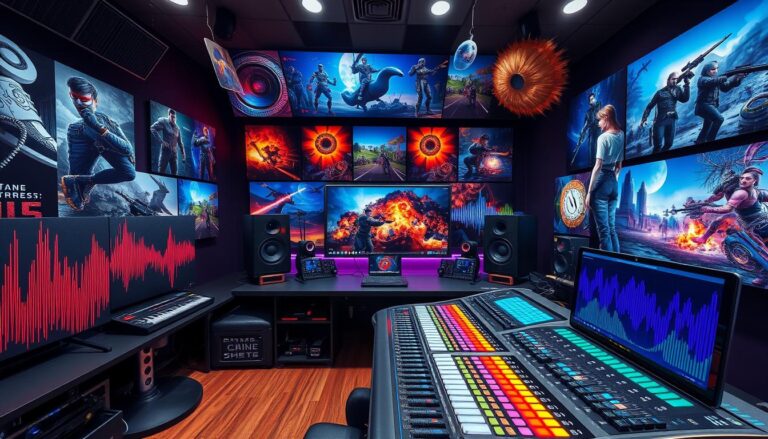How Can You Add Background Music to a Game?
In video games, background music is key to a great experience. It’s like in movies and TV, where sound and music pull you in. But, game makers often focus on gameplay, story, and graphics first.
To add background music, you can use different methods. One way is to make a Sound object. This can be either for a specific spot or for the whole game. For music that plays everywhere, link the Sound object to the SoundService.
Developers can upload their music or find it online. Then, they use scripts to control the music.
In Unity, adding music involves importing audio files and setting up an Audio Source. You can adjust settings like looping and volume. Scripts help with more complex music control.
Understanding the Fundamentals of Game Audio Integration
Game audio integration is key to making games more immersive and fun. It mixes different audio files and formats, like MP3, WAV, and OGG, into the game world. Knowing how to do this is vital for developers to make audio that makes the game better.
Types of Game Audio Files and Formats
Game developers use many audio file formats, each with its own strengths. The most popular ones are:
- MP3 – a format that balances file size and sound quality well
- WAV – offers top-notch sound but takes up more space
- OGG – a format that compresses audio efficiently without losing quality
Basic Audio Implementation Principles
Adding audio to games starts with creating Sound objects. You set their properties like volume and position. Then, you use scripts to control how they play. This way, developers can make a wide range of sounds, from background music to sounds that change with the game.
Role of Audio Middleware in Games
Audio middleware, like FMOD Studio and Wwise, is essential for managing game audio. These tools help developers create dynamic audio experiences. They make it easier to manage sound assets and set up complex audio effects. Using audio middleware can greatly improve a game’s audio quality.
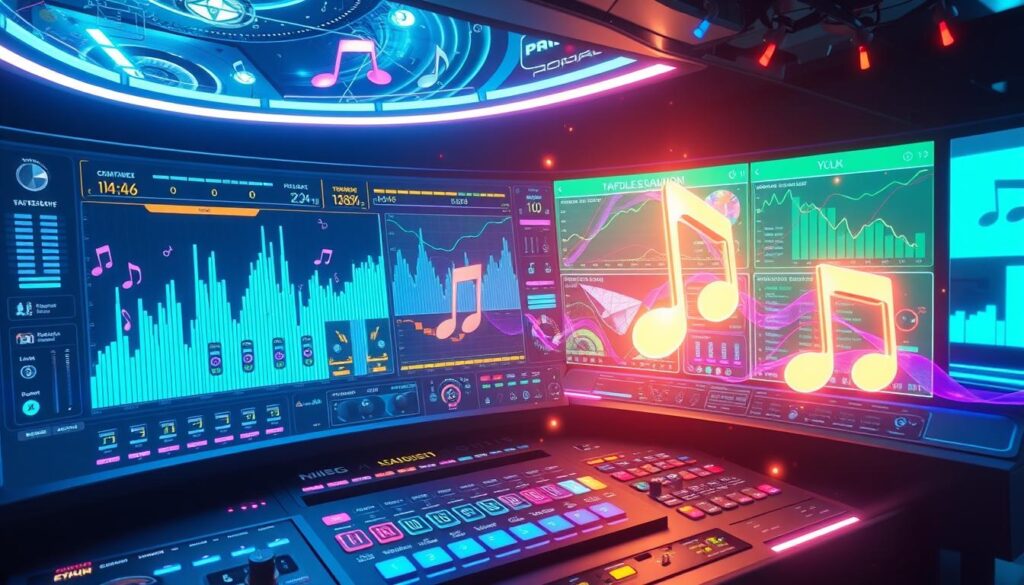
By grasping the basics of game audio integration, developers can craft audio that makes games more engaging. This includes knowing about different audio files, how to implement them, and the importance of audio middleware.
Game Sound Design and Audio Effects: A Comprehensive Overview
Making a game’s audio engaging is key in game development. Sound designers are crucial in adding music, sound effects, and dialogue. They make the game more immersive and fun. From foley effects to ambiance design and dialogue recording, their work is essential.
Sound designers aim to make the game’s audio both accurate and emotionally rich. They create sound effects that help players feel connected to the game. Ambient sounds like wind and water help set the scene, pulling players into the game world.
Recording dialogue is also vital. Voice actors bring characters to life, adding emotion and moving the story forward. Sound designers work with these actors to capture the perfect performance, fitting the game’s audio perfectly.
Sound designers also focus on mixing and balancing the audio. They adjust sound levels and positions to create a seamless experience. This ensures the audio enhances the game’s visuals and gameplay.
Game audio technology has grown a lot, allowing for more creativity. From simple 8-bit sounds to today’s complex audio, the field keeps evolving. This opens up new ways for sound designers to create memorable games.
| Book | Focus |
|---|---|
| “Video Game Audio: A History, 1972-2020” | Examines historical trends in video game sound and music from various gaming systems sold in North America, Europe, and Japan. |
| “Game Audio Programming 3: Principles and Practices” | Contains 14 chapters from top game audio programmers and sound designers targeting game audio programmers of all abilities. |
| “The Game Audio Strategy Guide” | Offers a theoretical foundation and practical insights to create industry-quality music and sound design for games, supported by a companion website with practical tutorials and exercises. |
| “Game Audio Fundamentals” | Provides an introduction to game audio design, covering analog and digital audio basics, sound effects, soundtracks, and voice production, along with practical examples and exercises. |
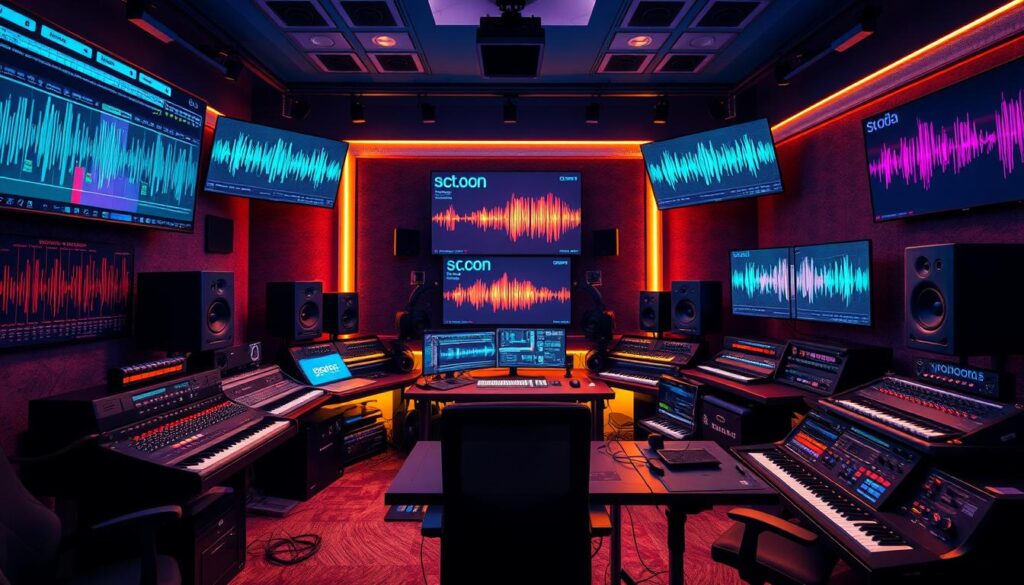
Setting Up Your Audio Environment in Game Engines
Creating immersive audio landscapes in game engines is key to engaging players. Whether using procedural audio, game engines, or adjusting audio source components, your audio setup matters a lot.
Configuring Audio Source Components
In Unity, start by making empty GameObjects and adding Audio Source components. These let you pick audio clips, set Loop and Play On Awake, and tweak volume, pitch, and position.
Managing Sound Objects and Properties
Organizing sound objects in a clear structure is vital for complex audio systems. Grouping sounds makes adjusting volume and pitch easier for whole groups, not just single sources. This boosts your control and simplifies audio management.
Creating Audio Hierarchies
With scripting, you can control audio playback and properties during gameplay. This lets you create interactive audio systems that react to player actions or game events. It makes the experience more immersive for your audience.
Mastering your audio environment setup in game engines is crucial. It helps create captivating soundscapes that blend well with your game’s visuals and interactions. This approach is essential for a truly immersive gaming experience for your players.
Implementing Background Music Through Scripting
In the world of interactive audio and game music, scripting is key. It helps game developers control the background music better. This way, the music fits perfectly with the game’s actions and events.
Developers often use a script to handle the Audio Source component. This script lets them play, stop, and adjust the music’s volume. It makes sure the music changes smoothly with the game’s events, creating a unified audio experience.
In engines like Unreal Engine, developers can set up sound cues. They use nodes to control looping and other music properties. This gives them detailed control over the audio, making it more dynamic as the game goes on.
Through scripting, developers can add cool features like:
- Seamless looping of background music for a continuous sound
- Changing the music volume based on player actions or game state
- Fading in and out the music for a more immersive experience
Scripting lets game audio fans create engaging background music. This music makes the game more enjoyable. It adds depth and emotion to the game’s world, enhancing the overall experience.
| Technique | Description | Benefits |
|---|---|---|
| Audio Source Management | Creating a script to control the Audio Source component, providing functions to play, stop, and adjust the background music | Enables dynamic music changes based on game events and overall control over the audio experience |
| Sound Cues and Nodes | Utilizing tools like sound cues and nodes in game engines (e.g., Unreal Engine) to set up looping and other properties for background music | Allows for a more granular level of audio scripting and customization |
| Seamless Looping | Implementing scripts to ensure the background music loops seamlessly, creating a continuous audio experience | Enhances the immersive quality of the game’s soundscape |
Sound Optimization and Performance Techniques
In the world of game development, making audio sound great is key. Using audio compression helps keep file sizes small without losing sound quality. This is vital for audio optimization. By using the latest compression methods, developers can make sure audio fits well in the game’s memory and runs smoothly.
Audio Compression Methods
Today’s audio compression, like MP3, Ogg Vorbis, and FLAC, helps keep files small while keeping sound quality high. These compression techniques help developers find the right balance. This ensures games run smoothly and sound great.
Memory Management for Game Audio
Good memory management is crucial for game audio. Developers can save memory by streaming audio tracks from disk instead of loading them all into memory. This way, important sounds are always ready, and less used ones load only when needed. This method boosts performance and uses resources wisely.
Streaming vs. Loading Options
- Streaming audio: Continuously loads audio data from disk as it’s needed, reducing the memory footprint.
- Loading audio: Pre-loads entire audio files into memory for immediate playback, providing faster access but potentially higher memory usage.
Choosing between streaming and loading audio depends on the game’s needs and goals. Finding the right mix of these methods is key. It helps developers give players the best audio experience possible.
Creating Dynamic and Interactive Audio Systems
In game audio, making audio systems that change with the game is key. Using procedural audio and interactive audio, developers can make sounds that fit the player’s actions. This makes the game feel more real and engaging.
Game audio engineers use audio middleware like Wwise and FMOD. These tools help create music that changes with the game. This way, the music fits perfectly with what’s happening in the game.
Procedural audio is another way to make games more interactive. It creates sounds on the fly, based on the game’s actions. This means less need for pre-made sounds, leading to more varied and real-time audio.
| Game Audio Tool | Unity Support | Pricing | Platforms |
|---|---|---|---|
| Wwise | Yes | Free for companies with a production budget below $250k, paid licenses start at $7,000 | iOS, Android, Windows Phone, Windows, Mac, Linux, PlayStation, Xbox, and more |
| FMOD | Yes | Free for developers below $200k in revenue, paid licenses start at $2,000 | iOS, Android, Windows Phone, Windows, Mac, Linux, PlayStation, Xbox, and more |
| Fabric | Yes | Free for projects below $250k, paid licenses start at $500 | iOS, Android, Windows Phone, Windows, Mac, Linux, PlayStation, Xbox, and more |
Using these audio systems, developers can make games that really grab players. By combining procedural audio, interactive audio, and audio middleware, they can make the audio fit perfectly with the game. This makes the game more immersive and enjoyable.
Conclusion
Adding background music and sound effects to games is key to a great gaming experience. Developers use different file formats and techniques to make the sound better. This makes the game more engaging and fun.
Games use 3D audio for virtual reality and optimize sound for mobile games. Techniques like binaural recording make games feel real. For example, Call of Duty: Modern Warfare 2 uses these to create a believable world.
The gaming world is always changing, and developers must keep up. They try new tools and techniques to make the audio experience better. By mixing music and sound effects well, they create games that players love.
